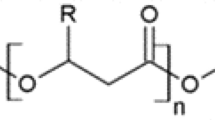Abstract.
This paper summarizes studies on microbial degradation of polyethers. Polyethers are aerobically metabolized through common mechanisms (oxidation of terminal alcohol groups followed by terminal ether cleavage), well-characterized examples being found with polyethylene glycol (PEG). First the polymer is oxidized to carboxylated PEG by alcohol and aldehyde dehydrogenases and then the terminal ether bond is cleaved to yield the depolymerized PEG by one glycol unit. Most probably PEG is anaerobically metabolized through one step which is catalyzed by PEG acetaldehyde lyase, analogous to diol dehydratase. Whether aerobically or anaerobically, the free OH group is necessary for metabolization of PEG. PEG with a molecular weight of up to 20,000 was metabolized either in the periplasmic space (Pseudomonas stutzeri and sphingomonads) or in the cytoplasm (anaerobic bacteria), which suggests the transport of large PEG through the outer and inner membranes of Gram-negative bacterial cells. Membrane-bound PEG dehydrogenase (PEG-DH) with high activity towards PEG 6,000 and 20,000 was purified from PEG-utilizing sphingomonads. Sequencing of PEG-DH revealed that the enzyme belongs to the group of GMC flavoproteins, FAD being the cofactor for the enzyme. On the other hand, alcohol dehydrogenases purified from other bacteria that cannot grow on PEG oxidized PEG. Cytoplasmic NAD-dependent alcohol dehydrogenases with high specificity towards ether-alcohol compound, either crude or purified, showed appreciable activity towards PEG 400 or 600. Liver alcohol dehydrogenase (equine) also oxidized PEG homologs, which might cause fatal toxic syndrome in vivo by carboxylating PEG together with aldehyde dehydrogenase when PEG was absorbed. An ether bond-cleaving enzyme was detected in PEG-utilizing bacteria and purified as diglycolic acid (DGA) dehydrogenase from a PEG-utilizing consortium. The enzyme oxidized glycolic acid, glyoxylic acid, as well as PEG-carboxylic acid and DGA. Similarly, dehydrogenation on polypropylene glycol (PPG) and polytetramethylene glycol (PTMG) was suggested with cell-free extracts of PPG and PTMG-utilizing bacteria, respectively. PPG commercially available is atactic and includes many structural (primary and secondary alcohol groups) and optical (derived from pendant methyl groups on the carbon backbone) isomers. Whether PPG dehydrogenase (PPG-DH) has wide stereo- and enantioselective substrate specificity towards PPG isomers or not must await further purification. Preliminary research on PPG-DH revealed that the enzyme was inducibly formed by PPG in the periplasmic, membrane and cytoplasm fractions of a PPG-utilizing bacterium Stenotrophomonas maltophilia. This finding indicated the intracellular metabolism of PPG is the same as that of PEG. Besides metabolization of polyethers, a biological Fenton mechanism was proposed for degradation of PEG, which was caused by extracellular oxidants produced by a brown-rot fungus in the presence of a reductant and Fe3+, although the metabolism of fragmented PEG has not yet been well elucidated.
Similar content being viewed by others
Author information
Authors and Affiliations
Additional information
Received revision: 18 September 2001
Electronic Publication
Rights and permissions
About this article
Cite this article
Kawai, .F. Microbial degradation of polyethers. Appl Microbiol Biotechnol 58, 30–38 (2002). https://doi.org/10.1007/s00253-001-0850-2
Received:
Accepted:
Issue Date:
DOI: https://doi.org/10.1007/s00253-001-0850-2




